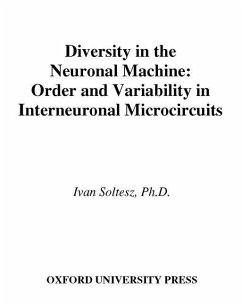The central aim of the book is to provide new insights into the striking degree of cellular diversity found in the interneuronal microcircuits in the brain's neocortex and hippocampus. It elaborates on novel ideas about interneuronal diversity that rest upon recent theoretical and experimental results concerning the developmental origins, the genetic and homeostatic regulation, and the functional roles of interneuronal heterogeneity, with arguments touching upon evolution, animal
behavior and the mathematical theory of small world networks. This engaging volume is invaluable to neuroscientists and others interested in neuronal network theory; neurologists and psychiatrists working on mechanisms of neurological and psychiatric disorders; and students and trainees in all these
fields.
This book is a colorful journey into the fascinatingly diverse world of interneurons, an important class of highly heterogeneous cells found in all cortical neuronal networks. Interneurons are known to play key roles in many brain functions, from sensory processing to neuronal oscillations linked to learning and memory. The central aim of the volume is to provide new insights into the striking degree of cellular diversity found in interneuronal microcircuits. The book discusses the
history of research into interneuronal variability, the developmental origins of interneuronal diversity, the functional roles of heterogeneity in neuronal circuits, contemporary interneuronal classification systems, and the genetic and homeostatic mechanisms that shape the degree of cell to cell
variability within interneuronal populations. It elaborates on new ideas about interneuronal diversity that rest upon theoretical and experimental results, with arguments touching upon evolution, animal behavior, and the mathematical theory of small world networks. This engaging volume is invaluable to neuroscientists and others interested in how neuronal newtworks function; electrical engineers, computational modelers, and physicists interested in neuronal network theory; neurologists and
psychiatrists working on mechanisms of neurological and psychiatric disorders; and students and trainees in all of these fields.
Hinweis: Dieser Artikel kann nur an eine deutsche Lieferadresse ausgeliefert werden.
behavior and the mathematical theory of small world networks. This engaging volume is invaluable to neuroscientists and others interested in neuronal network theory; neurologists and psychiatrists working on mechanisms of neurological and psychiatric disorders; and students and trainees in all these
fields.
This book is a colorful journey into the fascinatingly diverse world of interneurons, an important class of highly heterogeneous cells found in all cortical neuronal networks. Interneurons are known to play key roles in many brain functions, from sensory processing to neuronal oscillations linked to learning and memory. The central aim of the volume is to provide new insights into the striking degree of cellular diversity found in interneuronal microcircuits. The book discusses the
history of research into interneuronal variability, the developmental origins of interneuronal diversity, the functional roles of heterogeneity in neuronal circuits, contemporary interneuronal classification systems, and the genetic and homeostatic mechanisms that shape the degree of cell to cell
variability within interneuronal populations. It elaborates on new ideas about interneuronal diversity that rest upon theoretical and experimental results, with arguments touching upon evolution, animal behavior, and the mathematical theory of small world networks. This engaging volume is invaluable to neuroscientists and others interested in how neuronal newtworks function; electrical engineers, computational modelers, and physicists interested in neuronal network theory; neurologists and
psychiatrists working on mechanisms of neurological and psychiatric disorders; and students and trainees in all of these fields.
Hinweis: Dieser Artikel kann nur an eine deutsche Lieferadresse ausgeliefert werden.








